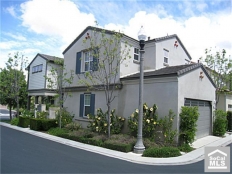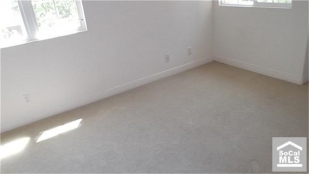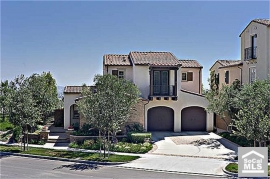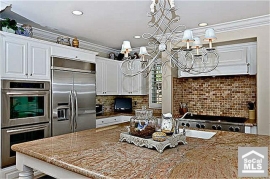With the ongoing failure of all other potential remedies to the excessive debt hangover from the housing bubble, a growing chorus of experts are starting to endorse foreclosure as the best remedy for the woes of loanowners.


Irvine Home Address … 339 DEERFIELD Ave #20 Irvine, CA 92606
Resale Home Price …… $360,700

Don't you know promises were never made to keep?
Just like the night, dissolve in sleep
I'll be your savior, steadfast and true
I'll come to your emotional rescue
Rolling Stones — Emotional Rescue
Borrowers need tough love. The truth of their suffering is rooted in their attachments to the house they occupy and the excessive debts they applied to it. These people need emotional rescue. Unfortunately, loan modifications are not the answer, and free-money gifts of principal reduction are not forthcoming. The rescue they need is a foreclosure.
Back in May of 2009, I asked if foreclosures were a crisis or a cure. I made the following observation:
The only rational method of principal reduction is through foreclosure. As a society, we need to stop viewing this as a “foreclosure crisis.” There is no foreclosure crisis; there is a debt disease, and foreclosure is the cure.
I followed that post in May 2010 with a detailed argument: Foreclosure is a superior form of principal reduction.
Ever since the Great Housing Bubble began to deflate, everyone has incorrectly identified the problem as foreclosure. The real problem is not foreclosure, the real problem is that borrowers have excessive debts due to the huge loans lenders underwrote that inflated the housing bubble. Foreclosure is not the problem, it is the cure. Further, there is only one reason foreclosure is seen as the problem: people have to move out of their homes after a foreclosure, and I have demonstrated how private hedge funds and other parties could solve that problem.
One way or another, the banks are going to write down huge amounts of bad debt. Nothing can save them, and we shouldn't try. Principal reductions are the worst possible solution to the problem of excess debt left over from the Great Housing Bubble. Principal reductions merely gives foolish borrowers a pass. If the borrowers go through foreclosure, they have consequences that minimize moral hazard:
- Borrowers will be forced to rent, at least for a time.
- Borrowers will have reduced access to consumer credit as the foreclosure lowers their FICO score.
- Borrowers will have to save and be prudent in order to meet the standards of home ownership and get another loan.
All of those consequences — inadequate though they may be — are eliminated if the GSEs merely reduce principal. The borrowers who have the most to gain are those who borrowed most foolishly, and the people paying the price are (1) prudent borrowers and (2) those who didn't borrow at all. Next time around, there will be no prudent borrowers, and everyone will participate. Who is going to pass on free money?
To further make the point, I wrote the post Foreclosures are essential to the economic recovery. The excessive debts and the diversion of income to lenders reduces disposable income and serves as a drag on the economy.
As long as the debt on real estate is excessive and capital is tied up in non-performing assets, the economy will suffer. It's really that simple. The solution is equally simple: foreclose on delinquent borrowers wiping out the debt and extract the remaining capital value. With the excess debt removed, borrowers can use their wage income to buy goods and services rather than giving it to the bank. When the mis-allocated capital is returned to the market, new investment will be spurred in areas where capital is most needed. Right now, we don't need more real estate.
Since all the previous solutions people have come up with have failed, the voices of reason are beginning to be heard in the mainstream media.
How to rescue the housing market: Foreclosures!
By Tami Luhby August 31, 2011: 5:27 AM ET
NEW YORK (CNNMoney) — If the Obama administration really wants to save the housing market, it should speed up the foreclosure process — not prolong the inevitable, experts say.
Four years into the housing crisis, the real estate market is still teetering on the edge. The Obama administration has tried one program after another to stem the tide of foreclosures with limited success.
Limited success? Loan modification programs have been a complete and utter failure. There is no measure of performance by which these programs can be considered even a partial success — except perhaps to the banks who merely hope to buy time.
And it is continuing to look for ways “to ease the burden on struggling homeowners,” though no new initiative is imminent, the White House said this week.
 If you want to ease the burden on struggling loanowners, foreclose on them and purge the debt. Foreclosure does that. Everyone keeps groping for a solution that allows those who have borrowed excessively to stay in their homes. That is wrongheaded. Loan modifications are the only viable alternative. Without debt reduction — and there should be no debt reduction — loan modifications still leave the borrower with a debt burden they will never pay off. That serves the bank, and for a time, the borrower might feel good about it. But over time, the borrower will come to realize they will never have equity, and they are merely renting money from the bank. Worse yet, the cost of rent on the money far exceeds the cost of renting a comparable property directly, and the money-rentership arrangement leaves them trapped in their homes.
If you want to ease the burden on struggling loanowners, foreclose on them and purge the debt. Foreclosure does that. Everyone keeps groping for a solution that allows those who have borrowed excessively to stay in their homes. That is wrongheaded. Loan modifications are the only viable alternative. Without debt reduction — and there should be no debt reduction — loan modifications still leave the borrower with a debt burden they will never pay off. That serves the bank, and for a time, the borrower might feel good about it. But over time, the borrower will come to realize they will never have equity, and they are merely renting money from the bank. Worse yet, the cost of rent on the money far exceeds the cost of renting a comparable property directly, and the money-rentership arrangement leaves them trapped in their homes.
But some housing experts argue that the administration should go in a different direction than it has in the past. Instead, they say it's time to focus on pushing many of those delinquent borrowers through the foreclosure process and putting foreclosed properties back into use.
We can't allow squatting to go on forever. Squatting is not a viable long-term solution to the housing crisis. If banks allow the squatting to continue, they have given away free homes. Lenders will have strongly rewarded the worst possible borrower behavior. It's moral hazard on steroids.
While some of the 2.2 million loans in foreclosure can still be saved, many are too far gone, they say. Some 37% have not made a payment in more than two years, while another 34% have not made a payment in 12 to 23 months, according to Lender Processing Services.
71% of delinquent loans in shadow inventory have been delinquent more than a year. Those are huge numbers. Millions and millions of homes are yet to go through the foreclosure process. These loans will not be cured through loan modification, and unless they win the lottery, none of the borrowers are going to become current by making up past payments.
“Loans enter into foreclosure, but never come out,” said Thomas Lawler, founder of Lawler Economic & Housing Consulting. “If this keeps going on, you have a continual overhang that never goes away.”
Delaying foreclosure increases the percentage of homeowners who'll likely never catch up, Lawler said. In 2009, only 6% of delinquent borrowers were more than two years behind. And it means vacant properties still in limbo could fall even further into disrepair, hurting the value of the surrounding housing market.
Thomas Lawler is exactly right. I know he has been working closely with Calculated Risk, and he has a thorough understanding of the problem and the implications of the solutions presented. The best case for resolving overhead supply is very slow appreciation as lenders sell into any price rallies. The most likely scenario is a slow deflation while lenders liquidate at a measured pace.
Lawler is not the first to warn about the consequences of slowing the foreclosure process. Since the housing crisis began, several experts cautioned that foreclosure prevention efforts may only prolong the pain.
Accelerating foreclosures is tricky, however, especially since it is largely the purview of the states. But the administration could work with state officials to speed the process, especially on vacant homes, he said.
I watch the foreclosure flow through the Las Vegas auction site every day. Whenever I see lenders postpone the auction on an empty property, I ask myself why. The only plausible answer is that they are managing the MLS inventory because if the auction happens the property will either be an REO or a flipper resale. Even with the legions of squatters gaming the system, lenders have a huge inventory of empty homes they could be processing if they wanted to.
The push would come at a time when many mortgage servicers have slowed foreclosure efforts as they resolve shoddy paperwork practices. Foreclosure filings in July dropped to their lowest level since November 2007, due to processing delays and foreclosure prevention measures, according to RealtyTrac.
 That is a red herring. The foreclosure delays are caused by lenders wanting to delay recognition of losses and to slow the double-dip in home prices brought about by the excessive inventory. Foreclosure prevention measures are responsible for delaying foreclosures, but with the high failure rates, they do little to actualy prevent foreclosures.
That is a red herring. The foreclosure delays are caused by lenders wanting to delay recognition of losses and to slow the double-dip in home prices brought about by the excessive inventory. Foreclosure prevention measures are responsible for delaying foreclosures, but with the high failure rates, they do little to actualy prevent foreclosures.
Getting rid of the glut
Another key to helping the housing market is facilitating the resale of homes that have already been foreclosed upon, experts said. This glut of vacant properties will continue to weigh on home values until they are sold.
“They can't be a glacier hanging over the market with everyone waiting for it to fall,” said Jim Gaines, research economist at The Real Estate Center at Texas A&M University. “Those properties have to clear the market.“
Most in the general public don't understand this. Properties witheld from the market temporarily do not help the market bottom. It may hold prices up for a short time, but these properties will eventually need to be liquidated. As they are sold, prices will fall. It does not need to be an avalanche which takes prices down quickly. It may be a slow bleed which takes prices down slowly over a long period of time.
A slow bleed is not better for the market. It traps more people underwater for longer periods of time, and it stops any buyers from having move-up equity to facilitate a move-up market. A speedy and steep decline followed by slow appreciation is much better for the overall health of the housing market.
A first step could be to sell off the foreclosed properties owned by Fannie Mae, Freddie Mac and the Federal Housing Administration. Collectively, they own 248,000 homes, about 31% of the foreclosure inventory.
The administration and the Federal Housing Finance Agency, which regulates Fannie Mae and Freddie Mac, are already looking for ways to unload these foreclosed homes. Earlier this month, they put out a request for ideas, including possible bulk sales of inventory. Also, they are interested in turning many of these properties into affordable rentals, which are sorely lacking in many communities. Experts interviewed agree this would be a good move for the market.
Apparently, the reporter interviewed some “experts” who have no idea what they are talking about. Turning REO into rentals is a very bad idea. The government has already proven to be a terrible landlord. There is little reason to believe they could effectively and efficiently manage a portfolio of millions of individual homes. Can you imagine the service requests they will get and what their response will be?
To entice investors to purchase these homes, as well as other foreclosed properties owned by banks, the administration could advocate for changes to the tax code, Gaines said. For instance, more favorable capital gains or depreciation rules could attract buyers.

The case against foreclosure
Of course, not everyone agrees that pushing people through the foreclosure process is the best solution to the housing crisis.
David Min, associate director for financial markets policy at the Center for American Progress, argues that there are many homeowners who can be saved if their payments can be adjusted to affordable levels or if some of their principal is forgiven.
Another pinhead who wants to encourage moral hazard by giving away free money to people who can't afford the houses they occupy. This solution is undoubtedly appealing to those who are squatting in houses they don't deserve to be in, but for those of us waiting to buy these properties, these are bad solutions that keep the undeserving in these properties at our expense.
This particularly applies to those who are only a few months behind.
Foreclosure is very costly for servicers, homeowners and neighborhoods, he said.
“There are a lot of other options that make more sense” than foreclosure, Min said. “It's just so destructive to value. We should be pulling every lever we can.”
No we shouldn't. It's fools like this who influence public policy. I'm sure he means well, but his dumb ideas are preventing an economic recovery.
Mediation, for instance, could help some homeowners avoid foreclosure, he said.
No. This merely delays foreclosure and allows people more time to squat in houses which should be put on the market for a new buyer who will pay less, have less debt, and likely be able to sustain ownership.
Some 23 states and the District of Columbia currently have programs that require mortgage servicers to sit down with borrowers and discuss the homeowners' options, though many began only in the last year. More than 70% of mediations end in a settlement, often restructuring the mortgage to a sustainable level, according to the center.
Helping those still current with their payments can also give the housing market — and the economy — a lift, albeit a somewhat marginal one, experts said.
Bullshit. The best thing for the economy is to purge the bad debt and get a new owner to occupy the property with less debt and more disposable income.
For instance, the administration could revamp its refinancing program aimed at allowing underwater homeowners to take advantage of today's lower interest rates.
No, this is an expensive idea that merely promotes imprudent borrowing.
Improvements could include reducing some of the upfront costs and underwriting requirements.
Lowering borrowers' monthly payments would give people more money to spend. And, for those on the edge, it could make it more likely that they will stay in their homes.
“It would be helpful to some borrowers with high rates,” Lawler said.
It would be helpful to borrowers with higher rates — at taxpayer expense. Foreclosure is still the best solution to the problem.
As someone who has argued for more foreclosures to clear the market and stimulate the economy, I am not surprised at the economic doldrums we are experiencing now or the wrongheaded policies which make our problems worse. Everything which has transpired over the last few years was easily foreseen by those who clearly understood the problem. Dean Baker among others has been consistently right about the housing bubble and the problems resulting from its deflation. It is gratifying to finally see the rest of the country awaken to the reality of our problems and the solutions required. If policymakers can overcome the emotional arguments favored by those who want to do the wrong thing, we might get back on the right track.
$264,880 of free money and over two years squatting
It should be apparent to anyone who reads this blog frequently that many California home owners managed their finances through Ponzi borrowing against the increasing equity in their homes. Most of these people didn't see the folly in what they were doing, and the rewards of this behavior was so great, the desire to own for free bank money will likely endure to inflate future housing bubbles.
Nowhere else do ordinary citizens put $35,000 into an investment and obtain over $250,000 in cash returns over a five-year period. California real estate is truly special.
Lenders inflated this bubble. By giving people free money, they made houses very desirable. This prompted the buying which kept the Ponzi scheme growing. When borrowers finally stopped paying lenders back, lenders stopped making loans, and the entire Ponzi scheme came abruptly to an end in a massive credit crunch.
Lenders deserve to bear the full brunt of the losses for their behavior. It's only through massive pain will they be cautious about inflating another bubble. If the rewards exceed the pain, lenders will do this again. The bailouts we gave lenders lessened this pain. Only time will tell if the pain has made them too cautious to repeat their mistake.
- The former owner of today's featured property paid $219,000 on 5/1/2000. She used a $175,120 first mortgage and a $43,880 down payment.
- On 6/1/2001 she obtained a $193,000 first mortgage and withdrew $18,000 of her down payment.
- On 4/7/2003 she refinanced with a $240,000 first mortgage and obtained a $57,000 HELOC. $100,000 more to spend.
-
On 12/26/2003 they enlarged their HELOC
 to $126,000
to $126,000 - On 11/12/2004 they obtained a $200,000 HELOC.
- On 11/2/2005 discovered the virtues of innovative financing. They obtained a $440,000 Option ARM with a 1.37% teaser rate.
- The quit paying in late 2008 and squatted until 3/11/2011.
Foreclosure Record
Recording Date: 06/14/2010
Document Type: Notice of Sale
Foreclosure Record
Recording Date: 04/15/2009
Document Type: Notice of Default
The bank lowered their opening bid at auction to $351,000, but it wasn't enough to attract a third party.
.png)
——————————————————————————————————————————————-
This property is available for sale via the MLS.
Please contact Shevy Akason, #01836707
949.769.1599
sales@idealhomebrokers.com


Irvine House Address … 339 DEERFIELD Ave #20 Irvine, CA 92606
Resale House Price …… $360,700
Beds: 2
Baths: 3
Sq. Ft.: 1367
$264/SF
Property Type: Residential, Condominium
Style: Two Level, Spanish
View: Park/Green Belt, Tree Top
Year Built: 1984
Community: Walnut
County: Orange
MLS#: P789308
Source: SoCalMLS
On Redfin: 47 days
——————————————————————————
Let's Make a Deal! Seller wants this Home Sold Today & they Mean Business. Bring your paint brush & decorating ideas as this Windwood Townhome offers lots of upside potential. Featuring a Main Floor Office-Den or Bedroom option with bathroom & laundry room, you'll be pleasantly surprised with 2 large bedrooms upstairs with private bathrooms in approx. 1,367 Sq. Ft. In addition, your kitchen with travertine counters & breakfast bar opens to your dining room & family room with vaulted ceilings & a cozy fireplace. If you love to entertain then move the party outdoors to your Large Wrap-Around Patio Backyard that is perfect for BBQ's. Conveniently located near Irvine schools, pools, tennis & basketball courts, tot-lots, parks, walking & bike trails, shops, restaurants, theatres & more. Hurry, this won't last!!!
——————————————————————————————————————————————-
Proprietary IHB commentary and analysis ![]()
Resale Home Price …… $360,700
House Purchase Price … $219,000
House Purchase Date …. 5/1/2000
Net Gain (Loss) ………. $120,058
Percent Change ………. 54.8%
Annual Appreciation … 4.4%
Cost of Home Ownership
————————————————-
$360,700 ………. Asking Price
$12,625 ………. 3.5% Down FHA Financing
4.26% …………… Mortgage Interest Rate
$348,076 ………. 30-Year Mortgage
$108,015 ………. Income Requirement
$1,714 ………. Monthly Mortgage Payment
$313 ………. Property Tax (@1.04%)
$0 ………. Special Taxes and Levies (Mello Roos)
$75 ………. Homeowners Insurance (@ 0.25%)
$400 ………. Private Mortgage Insurance
$288 ………. Homeowners Association Fees
============================================
$2,790 ………. Monthly Cash Outlays.jpg)
-$271 ………. Tax Savings (% of Interest and Property Tax)
-$479 ………. Equity Hidden in Payment (Amortization)
$19 ………. Lost Income to Down Payment (net of taxes)
$65 ………. Maintenance and Replacement Reserves
============================================
$2,125 ………. Monthly Cost of Ownership
Cash Acquisition Demands
——————————————————————————
$3,607 ………. Furnishing and Move In @1%
$3,607 ………. Closing Costs @1%
$3,481 ………… Interest Points @1% of Loan
$12,625 ………. Down Payment
============================================
$23,319 ………. Total Cash Costs
$32,500 ………… Emergency Cash Reserves
============================================
$55,819 ………. Total Savings Needed
——————————————————————————————————————————————————-





















.png)



























.jpg)

.png)

.png)


